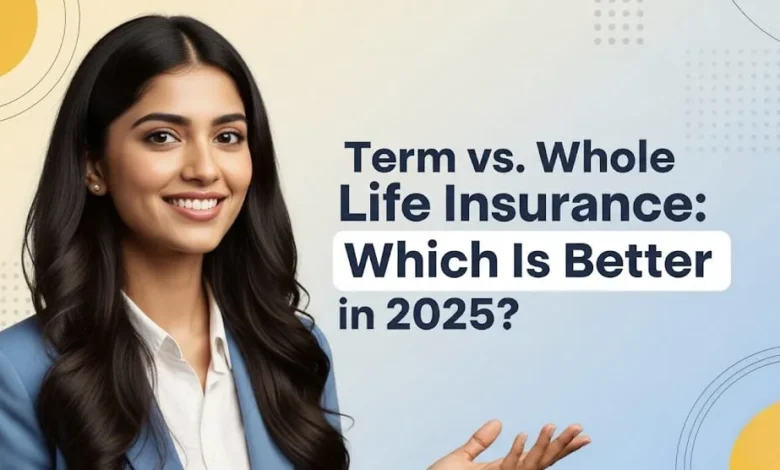Whole vs Term Life Insurance: Which Is Better in 2025?

Choosing the right life insurance policy can be one of the most important financial decisions you’ll make. In 2025, with the rise of digital tools and growing awareness of long-term financial planning, understanding the difference between whole life insurance and term life insurance has never been more critical.
This guide breaks down the key differences between whole and term life insurance, helping you make an informed decision that fits your goals and your budget.
🧠 What Is Life Insurance?
Life insurance is a contract between you and an insurance company. You pay premiums, and in return, your beneficiaries receive a death benefit if you pass away during the policy term. This helps cover costs like funeral expenses, debts, mortgages, and provides long-term financial security.
There are two main types of life insurance:
- Term Life Insurance – Coverage for a specific period (e.g., 10, 20, or 30 years)
- Whole Life Insurance – Permanent coverage with a cash value component
📌 Keywords: life insurance 2025, term life insurance vs whole life, best life insurance USA, compare life insurance policies
🧾 What Is Term Life Insurance?
Term life insurance provides coverage for a set number of years. If you die within that time, your beneficiaries receive the full death benefit. If the term ends and you’re still alive, coverage stops unless you renew or convert it.
✅ Pros of Term Life Insurance:
- More affordable than whole life
- Simple, easy-to-understand policies
- Ideal for short-term financial protection (e.g., mortgage, college tuition)
❌ Cons of Term Life Insurance:
- No payout if you outlive the term
- No cash value accumulation
- Renewal can get expensive as you age
Who Should Choose Term Life?
- Young families on a budget
- Individuals needing temporary coverage
- People focused on income replacement
🔗 Compare term life quotes on Policygenius
📌 Keywords: term life insurance 2025, affordable life insurance, temporary life insurance coverage
💼 What Is Whole Life Insurance?
Whole life insurance, also called permanent life insurance, provides lifetime coverage and builds cash value over time. This cash value grows at a guaranteed rate and can be borrowed against or withdrawn.
✅ Pros of Whole Life Insurance:
- Lifelong protection (as long as premiums are paid)
- Builds guaranteed cash value
- Can be used as a financial asset
- Fixed premiums that never increase
❌ Cons of Whole Life Insurance:
- More expensive than term policies
- Less flexibility with policy structure
- Slower return on investment compared to other savings tools
Who Should Choose Whole Life?
- High-income earners looking for long-term security
- People interested in estate planning
- Individuals seeking to build tax-deferred cash value
🔗 Learn more about whole life insurance at NerdWallet
📌 Keywords: whole life insurance 2025, permanent life insurance, cash value life insurance, lifetime insurance coverage
📊 Key Differences Between Whole and Term Life Insurance
| Feature | Term Life Insurance | Whole Life Insurance |
|---|---|---|
| Coverage Duration | 10–30 years | Lifetime |
| Premiums | Lower | Higher |
| Cash Value | None | Yes, grows over time |
| Policy Flexibility | Basic | Limited, but stable |
| Best For | Income replacement, low cost | Wealth building, long-term planning |
📌 Keywords: whole life vs term life comparison, life insurance benefits 2025, compare life insurance options
💡 Which Life Insurance Is Better in 2025?
The answer depends on your financial goals, age, income, and life stage.
Term Life May Be Better If:
- You need affordable protection during key years (kids in school, mortgage, etc.)
- You want to maximize your investment elsewhere
- You’re young and healthy
Whole Life May Be Better If:
- You want a guaranteed payout no matter when you pass
- You’re planning for long-term wealth or estate transfer
- You’re looking for a tax-advantaged savings vehicle
💰 Life Insurance Costs in 2025
In 2025, rates remain relatively stable but vary based on factors like age, health, term length, and coverage amount. Here are sample monthly premiums:
| Age | Term Life (20-Year Term, $500k) | Whole Life ($500k) |
|---|---|---|
| 30 | $25–$40 | $250–$350 |
| 40 | $40–$60 | $350–$500 |
| 50 | $70–$110 | $500–$700 |
🔗 Compare quotes from multiple insurers at SelectQuote
📌 Keywords: life insurance premiums 2025, affordable term life, cost of whole life insurance
🔄 Can You Convert Term Life to Whole Life?
Yes, many insurers allow you to convert a term policy into a whole life policy without a medical exam—usually before a certain age (often 65).
Benefits of converting include:
- Lifelong coverage
- Ability to build cash value
- Avoiding underwriting in older age
However, converted policies will carry higher premiums.
📌 Keywords: term to whole life conversion, life insurance without exam, convert life insurance 2025
🛠️ Tips for Choosing the Right Life Insurance Policy
- Assess your needs – debt, dependents, income replacement
- Compare quotes – Use comparison tools like Policygenius
- Work with a licensed agent – They can explain complex policies and help you find the best fit
- Reevaluate regularly – Your needs may change as you age or your family grows
🌱 Future Trends in Life Insurance (2025 and Beyond)
Life insurance is becoming more digital and customer-focused in 2025. Look for:
- AI-driven underwriting (faster, more accurate)
- No-exam policies with instant approval
- Flexible hybrid policies that blend term and whole features
- Mobile apps for policy management
- Sustainability discounts for healthy lifestyles
📌 Keywords: life insurance trends 2025, digital life insurance, no exam life insurance USA
✅ Final Thoughts: Term or Whole Life in 2025?
There’s no one-size-fits-all answer. Term life insurance is a smart choice if you want affordable, temporary coverage for major financial obligations. Meanwhile, whole life insurance can be a powerful financial tool for those who want guaranteed lifelong protection and cash value growth.
Start by evaluating your current financial situation and future goals. The best policy is the one that gives you peace of mind—and fits your budget.




